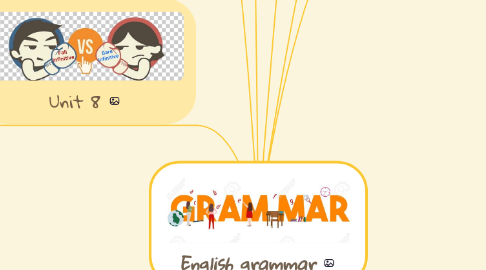
1. Unit 10
1.1. Must:
1.1.1. In the affirmative and interrogative form
1.1.2. In the negative form
1.2. Have to
1.2.1. In the affirmative and interrogative form
1.2.2. In the negative form to express absence of obligation
1.3. Need
1.3.1. As main verb in all tenses
1.3.2. As a modal verb only in the interrogative and negative of present simple
1.4. Should/ ought to
1.4.1. To ask advice
1.4.2. To make a suggestion
1.4.3. To express opinion
1.4.4. To make a mild obligation
1.5. Had better
1.5.1. To give advice
1.5.2. To express warning
2. Unit 9
2.1. -ing forms
2.2. After verbs which express preferences
2.3. After verbs which expresses beginning
2.4. After the verb go
2.5. After various verbs
2.6. After prepositions
3. Unit 8
3.1. Infinitive
3.1.1. We use full infinite:
3.1.1.1. We use bare infinite
3.1.1.2. After modal verbs: can, must, may, etc
3.1.1.3. After the verbs let and make in the active voice
3.1.2. 1-to express purpose
3.1.3. 2-after the verbs: want, would like, hope, etc
3.1.4. After adjectives such as glad, afraid, free, etc
3.1.5. After it + be + adjective
3.1.6. After too and enough
4. Unit 7
4.1. Relative clauses
4.1.1. Who:for people
4.1.1.1. Which: for animal, things and abstract nouns
4.1.1.1.1. That: is used for people
5. Unit 6
5.1. The use of an ,a
5.1.1. We use an, a before singular countable nouns.
5.1.1.1. 1-something not specific 2-professions
5.2. The use of the
5.2.1. 1-something specific 2-nouns which are unique 3-names of (seas, rivers, oceans, etc
5.2.2. Nationalities
5.2.3. Family names
5.2.4. Names of musical instruments
5.2.5. Adj and adverbs in the superlative form
5.3. Countable and uncountable nouns
5.3.1. Countable nouns: have singular and plural forms. We can use a/an before them in the singular and numbers, some, etc
5.3.1.1. Uncountable noun have only a singular form. We can not use a/an or numbers before them
5.4. Plural verbs
5.4.1. We use Are, were
6. Unit 5
6.1. Present perfect simple
6.1.1. For action which happened in the past but not mentioned the time
6.1.2. Action that has been completed recently
6.2. Present perfect progressive
6.2.1. Action started in the past and still continue up the present
6.2.2. For action which were happening in the past and may or may not have finished
6.2.3. Action started in the past and continue up to the present
7. Unit 3
7.1. Past progressive
7.1.1. For an action which was happening in the past when anther one interrupted
7.1.2. For more then one action happening at the same time
7.1.3. Describe the setting in a narrative
7.1.4. For action which were happening at specific point of time in the past
7.1.5. Past simple
7.1.5.1. For action which happened at a specific time
7.1.5.2. For a past habits and repeated action: every Sunday
7.1.5.2.1. Use used to to describe action which we did in the past
7.1.5.3. Action that happened one after the other in the past
8. Unit 4
8.1. Word order
8.1.1. 1.subject 2.verb 3.object
8.1.2. Adverbs and expressions the indicate manner, place and time follow by order
8.1.2.1. Note
8.1.2.1.1. After verbs the indicate movement (go, run, etc
8.2. Verb will two objects
8.2.1. The normal word order in a sentence with verb the takes to object
8.2.1.1. Subject, verb, indirect object, direct object
8.3. Prepositions of time
8.3.1. To show the exact time with expressions..
8.3.1.1. At, on , in during , before, after
8.3.2. Prepositions of place
9. Unit 1
9.1. Present simple
9.1.1. For repeated action,general truths ,permanent state in the present
9.1.1.1. Time expressions
9.1.1.2. Always,usually,often
9.1.2. Stative verbs are usually describe:
9.2. Present progressive
9.2.1. For action that are happening right now, for temporary actions, for action that we have planned to do in the near future
9.2.1.1. Time expression
9.2.1.2. Now, at present, today
9.3. Stative verbs
9.3.1. Senses, emotions, permanent states
10. Unit 2
10.1. Future well
10.1.1. For design we make at the moment ,for promises,warning or threat,for predictions
10.1.1.1. Time expression
10.1.1.2. Tomorrow, tonight, next month, Tuesday ,etc
10.2. Future going to
10.2.1. For action that we instead to do in the future, for predictions based on evidence
10.2.1.1. when the time clause comes before the main clause, the tow clauses are separated by a comma
10.2.1.1.1. When the main clauses comes before the time clause,the tow clauses are not separated by a comma .
10.2.1.1.2. New Topic
10.3. Time clauses
10.3.1. Express time in relation to the main clause
10.3.2. They introduced by words such as when, after ,before ,until, while, as soon as, by the time
